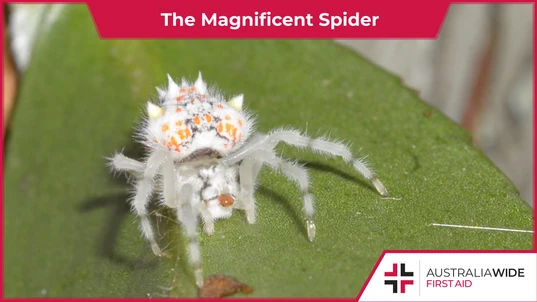Your Guide to the Magnificent Spider

Bites and Stings

The Magnificent spider is renowned for distinctive markings on its abdomen, as well as an ingenious method for capturing moths. They are common in forests and suburban gardens in New South Wales and Queensland. (Photo credit: woeful_haichi/Reddit)
Commonly encountered in Queensland and New South Wales, the female Magnificent spider (Ordgarius magnificus) is renowned for distinctive markings on its abdomen. They also have an ingenious method for capturing moths. In this article, we will look closely at this elusive arachnid, and where you are likely to encounter one. We also cover spiders and spider bites in the following courses: You can head to our website to enrol in a location near you.Appearance
The female Magnificent spider has the following identifying characteristics:- Creamy white body and legs that are covered in long fine hairs
- Two bright yellow knobs on its abdomen, and a series of salmon-coloured spots and blotches
- Size ranging from 14 mm - 25 mm
Distribution
The Magnificent spider can be found along the Australian east coast, from Townsville in the north to Tasmania in the south, including: Their preferred habitat includes dry or wet sclerophyll forests, where they hide between leaves that they bind together with silk.Feeding and behaviours
Like other bolas spiders, the Magnificent spider uses deception to capture its preferred prey - moths. At night, the Magnificent spider spins a short line of silk with a sticky globule, or bolas, at the free end. This globule may emit an airborne pheromone that imitates the scent of female moths belonging to the Noctuidae family, thereby attracting male moths of the same genealogy. The Magnificent spider has vibration sensitive hairs on its legs. As such, when it senses the approach of a moth in flight, it twirls the silken thread and swings the globule around until it hits the moth. It then hauls the moth up and bites and immobilises it, either to eat it immediately or stow it away for safekeeping. Female Magnificent spiders also use their spinnerets to construct brown, spindle shaped egg sacs that can be up to 5 cm long and house roughly 600 eggs.Danger to humans
The Magnificent spider is not considered dangerous to humans. However, if you are bitten by one, it is better to be safe than sorry and follow the first aid procedure for a Redback spider bite.Final thoughts
We can teach you how to identify and treat spider bites in the following first aid courses: You can head to our website to enrol in a location near you.
Originally published at
https://www.australiawidefirstaid.com.au/resources/magnificent-spider
as part of the Australia Wide First Aid Articles Library









